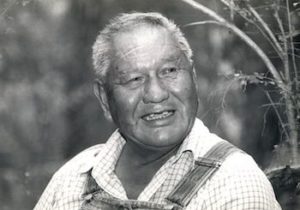
Bel Abbey
*Bel Abbey was born on this date on this date in 1916. He was a Black Native American Coushatta Indian Blowgun Maker, Wood Carver, herbalist, and Koasati Storyteller.
Abbey was from a Koasati settlement five miles north of Elton, Louisiana. Abbey was the last generation raised in the traditional Koasati social and economic system. He was taught traditionally by his grandmother, mother, and maternal uncles; his life showcases the intersectionality between Africans and Native indigenous people in America. Abbey had only three years of formal education and learned to read and write during World War II. Bel Abbey was a skilled hunter with astute knowledge of animal behavior.
He had extensive knowledge of natural history and knew the names of hundreds of plants and their uses. In addition, he was extremely well-schooled in the Koasati stories he had listened to all his life. Abbey was interested in preserving traditional crafts and was skilled in making blowguns, darts, bows, arrows, whistles, Spanish moss spinners, and other pieces.
He preserved many baskets made by his mother, a master of traditional basket weaving. Abbey grew up speaking Koasati, a language related to Creek, Alibamu, and Seminole. He had to master English on his own. Later, he learned to speak Alibamu, Choctaw, Mobilian, and Cajun French. His linguistic and teaching skill was what attracted ethnologists and linguists to him. Bel Abbey would soon become an invaluable resource for anthropologists and historians and as an interpreter for his mother, who only spoke Koasati. Abbey was active in his community and church. He sang in the choir and worked with the pastor on projects to benefit the community. His later life was spent working to preserve and share the language, skills, and traditions of Koasati culture. He helped translate the Bible into Koasati and recorded the language and traditional stories. In 1991, his hard work contributed to the publication of Koasati Grammar.
Bel Abbey was inducted into the Hall of Master Folk Artists in 1982. He represented the Koasati at the Natchitoches-NSU Folk Festival, The World's Fair in New Orleans, the Louisiana State Folk Festival, and the Smithsonian's National Folk Festival on the Mall. When he died in 1991, he was looking for overdrafts of the Koasati Dictionary.
Louisiana Folklife Center, NSU Campus, Kyser Hall RM 213, Natchitoches, LA 71497